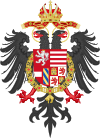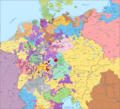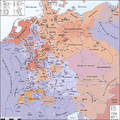Ferdinand II, Holy Roman Emperor facts for kids
Quick facts for kids Ferdinand II |
|
|---|---|

Emperor Ferdinand II in 1614
|
|
| Holy Roman Emperor (more...) | |
| Reign | 28 August 1619 – 15 February 1637 |
| Proclamation | 9 September 1619, Frankfurt |
| Predecessor | Matthias |
| Successor | Ferdinand III |
| Born | 9 July 1578 (NS: 19 July 1578) Graz, Duchy of Styria, Austria |
| Died | 15 February 1637 (aged 58) Vienna, Austria |
| Burial | Mausoleum in Graz (body) Augustinian Church (heart) |
| Spouse | |
| Issue full list... |
|
| House | Habsburg |
| Father | Charles II, Archduke of Austria |
| Mother | Maria Anna of Bavaria |
| Religion | Roman Catholicism |
Ferdinand II (born 9 July 1578 – died 15 February 1637) was a powerful ruler in Europe. He was the Holy Roman Emperor, and also the King of Bohemia, Hungary, and Croatia. He ruled from 1619 until his death in 1637. Ferdinand was a member of the Habsburg family, which was very important in European history.
Ferdinand was known for being a very Catholic ruler. He strongly believed in his faith and wanted to bring back the Catholic Church as the main religion across his lands. This led to many conflicts, especially with Protestants. His actions played a big part in starting the Thirty Years' War, a long and destructive war that affected much of Europe.
Contents
Early Life and Education
Ferdinand was born in Graz, Austria, on 9 July 1578. His father was Charles II, Archduke of Austria, and his mother was Maria of Bavaria. Both of his parents were very religious Catholics.
When Ferdinand was 8 years old, he started school with the Jesuits in Graz. The Jesuits were a Catholic religious order known for their excellent schools. To keep him away from Protestant nobles, his parents sent him to study at the Jesuits' college in Ingolstadt, Bavaria, when he was 12.
In July 1590, when Ferdinand was still young, his father died. Ferdinand inherited the lands of Inner Austria, which included Styria, Carinthia, and Carniola. Since he was too young to rule, his cousin, Rudolf II, Holy Roman Emperor, appointed temporary rulers for these lands.
Ferdinand finished his studies in 1594. He promised to support the Jesuits and their university. He returned to Graz and became the ruler of Inner Austria when he was 17.
Becoming a Ruler
Ferdinand officially became the ruler of Styria in December 1596. Soon after, other Inner Austrian provinces also accepted him as their leader. He kept the traditional government system but made sure only Catholics held the highest positions.
He met with Emperor Rudolf II in Prague and shared his plans to strengthen Catholicism. Rudolf II agreed that Ferdinand could decide on religious matters in his lands. He also gave Ferdinand the job of defending Croatia, Slavonia, and parts of Hungary from the Ottoman Turks.
Counter-Reformation Efforts
Ferdinand was very serious about bringing back Catholicism. In 1598, he started strict measures called the Counter-Reformation. He ordered all Protestant pastors and teachers to leave Styria, Carinthia, and Carniola. He believed that religious matters were his royal right, and the nobles could not tell him what to do.
He also set up special groups to restore Catholic churches in towns and villages. These groups could even use military force if needed. Local Protestants had to choose between becoming Catholic or leaving the province. However, he did not force Protestant noblemen to convert, but they could not hire Protestant priests.
Early Challenges and Conflicts
In 1600, the Ottomans captured Nagykanizsa in Hungary, which made Styria vulnerable. Ferdinand tried to get it back in 1601 but failed. He also got involved in family disputes within the Habsburg family, known as the "Brothers' Quarrel."
Ferdinand initially supported his cousin Matthias against Emperor Rudolf II. However, Matthias made too many promises to Protestants, which angered Ferdinand. Ferdinand wanted to form an alliance to strengthen the Catholic Church.
Path to Emperor
In 1617, Philip III of Spain agreed that Ferdinand should be the next ruler of Bohemia and Hungary after Matthias. Spain also helped Ferdinand in a war against the Republic of Venice. The nobles in Bohemia and Hungary agreed to accept Ferdinand as their future king, but only if he promised to respect their special rights.
A disagreement over a document called the Letter of Majesty, which protected Protestant freedoms in Bohemia, led to a rebellion. On 23 May 1618, an event called the Second Defenestration of Prague happened. Protestant nobles threw two royal officials out of a window, which is seen as the start of the Thirty Years' War.
The Bohemian rebels formed a temporary government and sought help from others who opposed the Habsburgs. Emperor Matthias died on 20 March 1619. Ferdinand was elected Holy Roman Emperor on 28 August 1619. Just two days before, the Bohemian nobles had removed him as their king and offered the crown to Frederick V of the Palatinate, a Protestant ruler.
The Thirty Years' War
Ferdinand's strong Catholic beliefs and his actions against Protestantism caused the Thirty Years' War to spread across the entire Holy Roman Empire. As a devout Catholic, he wanted to make the Catholic Church the only religion in the Empire. This long war caused huge destruction and loss of life.
Bohemian Revolt and Imperial Power
When the Bohemian revolt began, Ferdinand was in Hungary. He tried to negotiate, but the rebels refused. They formed a confederation and officially removed Ferdinand as their king in August 1619.
Ferdinand was elected Holy Roman Emperor on 28 August 1619. He then made an alliance with Maximilian I, Elector of Bavaria, who led the Catholic League. Ferdinand's forces, led by General Johann Tserclaes, Count of Tilly, and his allies invaded Bohemia. On 8 November 1620, they decisively defeated the Bohemian rebels and their allies at the Battle of White Mountain.
After this victory, Ferdinand took strong actions to bring Bohemia back to Catholicism. Many Protestant leaders were executed, and their lands were taken away. Protestantism almost disappeared in Bohemia and Austria in the following years.
Financial Struggles and New Allies
Despite military successes, Ferdinand faced financial problems. In 1625, he turned to Albrecht von Wallenstein, a very rich nobleman, to raise an army. Wallenstein agreed, but he wanted full control over the army and its spoils. He built a huge army that defeated Protestants in Silesia, Anhalt, and Denmark.
In 1629, Ferdinand issued the Edict of Restitution. This order demanded that all lands taken from Catholics since 1552 be returned. This made Protestants even more angry.
Swedish Intervention and Wallenstein's Fall
The Edict of Restitution and Catholic military successes led Gustavus Adolphus, the King of Sweden, to join the war on the Protestant side. Some of Ferdinand's allies started to complain about Wallenstein's power and his harsh ways of funding his army. Ferdinand removed Wallenstein from command in 1630.
The leadership of the war then went to General Tilly. However, Tilly was unable to stop the Swedish army. Tilly died in battle in 1632. Wallenstein was called back and quickly raised another army.
Wallenstein achieved some victories, but his actions became suspicious. He was assassinated in 1634. Despite this, the imperial forces won another important battle at Nördlingen. This weakened the Swedish army.
France Enters the War
The growing power of the Habsburgs worried France. Louis XIII of France and his chief minister, Cardinal Richelieu, decided to join the war on the Protestant side in 1635. This made the war even bigger and more complicated.
In 1635, Ferdinand signed the Peace of Prague (1635). This agreement brought some peace among German states, but it did not end the larger war.
Later Life and Legacy
Ferdinand II died on 15 February 1637. He left his son, Ferdinand III, Holy Roman Emperor, an empire still deeply involved in the Thirty Years' War. Ferdinand II was buried in his family mausoleum in Graz. His heart was buried separately in the Augustinian Church in Vienna.
His strong religious beliefs shaped his rule and led to one of the most destructive wars in European history. He was determined to restore Catholicism, which had a lasting impact on the religious map of his lands.
Marriages and Children
Ferdinand II was married twice.
In 1600, he married Maria Anna of Bavaria (1574–1616). They had seven children:
- Archduchess Christine (born and died 1601)
- Archduke Charles (born 1603)
- Archduke John-Charles (1605–1619)
- Ferdinand III (1608–1657), who became the next Holy Roman Emperor.
- Archduchess Maria Anna of Austria (1610–1665)
- Archduchess Cecilia Renata of Austria (1611–1644), who married the King of Poland.
- Archduke Leopold Wilhelm of Austria (1614–1662).
In 1622, he married Eleonora Gonzaga. They did not have any children together.
Titles
Ferdinand II held many important titles. He was the elected Holy Roman Emperor, King in Germany, King of Hungary, Bohemia, and Croatia. He was also the Archduke of Austria and held many other ducal and princely titles across Europe.
Images for kids
-
The meeting of Emperor Rudolph II and his brother, Archduke Matthias near Prague in 1608.
-
Religious situation in the Holy Roman Empire at the outbreak of the Thirty Years' War in 1618.
-
The Battle of White Mountain (1620) in Bohemia was one of the decisive battles of the Thirty Years' War that ultimately led to the forced conversion of the Bohemian population back to Roman Catholicism.
-
Eleonora Gonzaga in her wedding dress, by Justus Sustermans, 1621/22. Kunsthistorisches Museum, Vienna.
-
Ferdinand II, Holy Roman Emperor and his second wife, Eleonora Gonzaga, Princess of Mantua. Even though they had no children, their marriage was perceived to be a "happy" one.
See also
 In Spanish: Fernando II del Sacro Imperio Romano Germánico para niños
In Spanish: Fernando II del Sacro Imperio Romano Germánico para niños
- Kings of Germany family tree. He was related to every other king of Germany.














